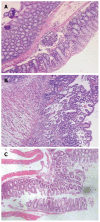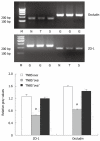Schistosoma japonicum ova maintains epithelial barrier function during experimental colitis
- PMID: 22147983
- PMCID: PMC3229631
- DOI: 10.3748/wjg.v17.i43.4810
Schistosoma japonicum ova maintains epithelial barrier function during experimental colitis
Abstract
Aim: To evaluate the impacts of Schistosoma japonicum (S. japonicum) ova on the tight junction barriers in a trinitrobenzenesulfonic acid (TNBS)-induced colitis model.
Methods: Balb/c mice were randomly divided into three groups: control group; TNBS(+)ova(-) group and TNBS(+)ova(+) group. TNBS was used intracolonic to induce colitis and mice of the TNBS(+)ova(+) group were pre-exposed to S. japonicum ova as a prophylactic intervention. Colon inflammation was quantified using following variables: mouse mortality, weight loss, colon extent and microscopic inflammation score. Serum expression of tumor necrosis factor-α and interferon-γ were assessed to evaluate the systemic inflammatory response. NOD2 and its mRNA were also tested. Bacterial translocations were tested by culturing blood and several tissues. ZO-1 and occludin were chosen as the representations of tight junction proteins. Both the proteins and mRNA were assessed.
Results: Ova pre-treatment contributed to the relief of colitis and decreased the mortality of the models. NOD2 expression was significantly downregulated when pretreated with the ova. The TNBS injection caused a significant downregulation of ZO-1 and occludin mRNA together with their proteins in the colon; ova pre-exposure reversed these alterations. Treatment with S. japonicum ova in the colitis model caused lower intestinal bacterial translocation frequency.
Conclusion: S. japonicum ova can maintain epithelial barrier function through increasing tight junction proteins, thus causing less exposure of NOD2 to the luminal antigens which may activate a series of inflammatory factors and induce colitis.
Keywords: Crohn’s disease; Occludin; Schistosoma japonicum ova; Tight junction protein; ZO-1.
Figures






Similar articles
-
Preventive effects of Schistosoma japonicum ova on trinitrobenzenesulfonic acid-induced colitis and bacterial translocation in mice.J Gastroenterol Hepatol. 2009 Nov;24(11):1775-80. doi: 10.1111/j.1440-1746.2009.05986.x. J Gastroenterol Hepatol. 2009. PMID: 20136961
-
[Isongifolene Improves Crohn's Disease-Like Colitis in Mice by Reducing Apoptosis of Intestinal Epithelial Cells].Sichuan Da Xue Xue Bao Yi Xue Ban. 2024 Sep 20;55(5):1175-1185. doi: 10.12182/20240960204. Sichuan Da Xue Xue Bao Yi Xue Ban. 2024. PMID: 39507978 Free PMC article. Chinese.
-
[Effect of schistosome ova on Trinitrobenzenesulfonic acid induced colitis in mice].Zhonghua Yi Xue Za Zhi. 2007 Aug 14;87(30):2149-51. Zhonghua Yi Xue Za Zhi. 2007. PMID: 17988539 Chinese.
-
Probiotic mixture VSL#3 protects the epithelial barrier by maintaining tight junction protein expression and preventing apoptosis in a murine model of colitis.Am J Physiol Gastrointest Liver Physiol. 2009 May;296(5):G1140-9. doi: 10.1152/ajpgi.90534.2008. Epub 2009 Feb 12. Am J Physiol Gastrointest Liver Physiol. 2009. PMID: 19221015
-
Moxibustion down-regulates colonic epithelial cell apoptosis and repairs tight junctions in rats with Crohn's disease.World J Gastroenterol. 2011 Dec 7;17(45):4960-70. doi: 10.3748/wjg.v17.i45.4960. World J Gastroenterol. 2011. PMID: 22174545 Free PMC article.
Cited by
-
Larval Echinococcus multilocularis infection reduces dextran sulphate sodium-induced colitis in mice by attenuating T helper type 1/type 17-mediated immune reactions.Immunology. 2018 May;154(1):76-88. doi: 10.1111/imm.12860. Epub 2017 Dec 8. Immunology. 2018. PMID: 29121394 Free PMC article.
-
Schistosoma japonicum peptide SJMHE1 inhibits acute and chronic colitis induced by dextran sulfate sodium in mice.Parasit Vectors. 2021 Sep 6;14(1):455. doi: 10.1186/s13071-021-04977-y. Parasit Vectors. 2021. PMID: 34488863 Free PMC article.
-
Helminth Therapy: Advances in the use of Parasitic Worms Against Inflammatory Bowel Diseases and its Challenges.Helminthologia. 2018 Jan 27;55(1):1-11. doi: 10.1515/helm-2017-0048. eCollection 2018 Mar. Helminthologia. 2018. PMID: 31662622 Free PMC article.
-
Schistosome Egg Migration: Mechanisms, Pathogenesis and Host Immune Responses.Front Immunol. 2018 Dec 20;9:3042. doi: 10.3389/fimmu.2018.03042. eCollection 2018. Front Immunol. 2018. PMID: 30619372 Free PMC article. Review.
-
Schistosoma japonicum attenuates dextran sodium sulfate-induced colitis in mice via reduction of endoplasmic reticulum stress.World J Gastroenterol. 2017 Aug 21;23(31):5700-5712. doi: 10.3748/wjg.v23.i31.5700. World J Gastroenterol. 2017. PMID: 28883695 Free PMC article.
References
-
- MacDonald TT, Monteleone G, Pender SL. Recent developments in the immunology of inflammatory bowel disease. Scand J Immunol. 2000;51:2–9. - PubMed
-
- Elson CO, Cong Y, Weaver CT, Schoeb TR, McClanahan TK, Fick RB, Kastelein RA. Monoclonal anti-interleukin 23 reverses active colitis in a T cell-mediated model in mice. Gastroenterology. 2007;132:2359–2370. - PubMed
-
- Schreiber S, Khaliq-Kareemi M, Lawrance IC, Thomsen OØ, Hanauer SB, McColm J, Bloomfield R, Sandborn WJ. Maintenance therapy with certolizumab pegol for Crohn’s disease. N Engl J Med. 2007;357:239–250. - PubMed
-
- Takesue Y, Ohge H, Uemura K, Imamura Y, Murakami Y, Yokoyama T, Kakehashi M, Sueda T. Bacterial translocation in patients with Crohn’s disease undergoing surgery. Dis Colon Rectum. 2002;45:1665–1671. - PubMed
MeSH terms
Substances
LinkOut - more resources
Full Text Sources

